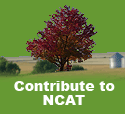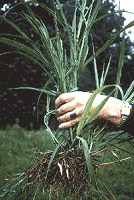skip
navigation  |
800-411-3222 (Español)
Alternative Control of Johnsongrass |
| By Preston Sullivan NCAT Agriculture Specialist Published 2002 ATTRA Publication #CT116 |
The
printable PDF version of the entire document is available
at: http://attra.ncat.org/attra-pub/PDF/johnson.pdf 2 pages — 117K Download Acrobat Reader |
Johnsongrass reproduces readily from seed, rootstock, and underground rhizomes. Stands of johnsongrass are thickened and improved by disking and other forms of tillage that cut and spread rhizomes. On the other hand, defoliation (by grazing, mowing, burning, etc.) prior to maturity reduces rhizome production, which peaks just prior to heading. Preventing seed production is also essential to controlling spread of the plant. (1)
Light infestations of seedling johnsongrass in row-crop and vegetable fields can usually be controlled by regular cultivation and crop competition. Escaped plants, however, must be dealt with by hand-hoeing or other means to prevent seed production. Where the weed population has reached problem levels, more strategy is required. In the enclosed section below is an old USDA Farmer's Bulletin, Johnson Grass as a Weed, which discusses means of control without herbicides. The bulletin mentions several options:
An important component of these strategies is keeping top growth down. This is aimed at preventing the root and rhizome system from producing "tertiary growth." Tertiary root growth starts about the time of flowering. It is these roots that overwinter, and from which the plant will sprout the following spring. If tertiary growth is suppressed, cultivation is more likely to kill the roots and rhizomes. For more detail on root growth and how to manage it, request the enclosure USDA Farmer's Bulletin No. 279, p. 7. Johnsongrass makes good forage. It is a higher-energy grass in relation to crude protein, so excellent gains by cattle can be achieved. Troubled fields can be converted to pasture, turning a problem into an income source. Though continuous grazing is not best for pasture grasses in general, better johnsongrass control will result from it rather than from rotational grazing. Continuous grazing will deplete the rhizomes and eventually kill the plants. The grazing must be managed to avoid prussic acid poisoning, which can occur when johnsongrass is grazed after frost, after drought stress, or in the early growth stages. Two herbicidal techniques using Roundup™ for johnsongrass control qualify as low-input and low-impact. A systemic, nonselective herbicide, Roundup™ moves throughout the plant, usually eliminating regrowth from the roots. The first technique, spot spraying with Roundup™, can be effective in eliminating johnsongrass hot spots. Secondly, applying Roundup™ with a rope wick applicator where the weed towers above the crop, is also a target-specific method. The rope wick applicators function like sponge mops, absorbing and holding the herbicide. The chemical is then "wiped" directly onto the weed. Rope wick applicators are available in hand-held and tractor-mounted models. References
EnclosuresAnon. 1992. He wipes weeds as he cultivates. Farm Show. Vol. 16, No. 5. p. 6. Cates, J.S., and W.J. Spillman. 1907. A Method of Eradicating Johnsongrass. USDA Farmers' Bulletin 279. 16 p. Hutchinson, M. 1992. Vegetation management guideline: Johnsongrass. Natural Areas Journal. October. p. 219-220. McWhorter, C.G. 1981. Johnsongrass as a Weed. USDA Farmers' Bulletin 1537. 19 p. Alternative Control of Johnsongrass
|
||
|
Site Map | Comments | Disclaimer | Privacy Policy | Webmaster Copyright © NCAT 1997-2009. All Rights Reserved. |



